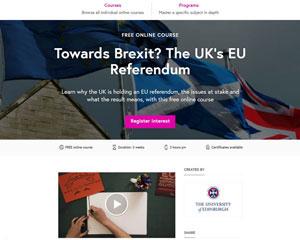Designing a Massive Open Online Course (MOOC)
MOOCs are a constantly evolving form of digital outreach, combining elements of education and public engagement. Anthony Salamone outlines some points to keep in mind when designing one.
 Example of a MOOC homepage
Example of a MOOC homepage
A Massive Open Online Course (MOOC) is a large-scale digital course designed to appeal to and engage with a wide audience on a subject of general interest. In that sense, MOOCs reach many varieties of learners, from students in secondary or tertiary education to workers looking to develop an interest or acquire a (career-related) skill, to retirees exploring new pursuits. Depending on the subject matter, participants can be extremely well-versed on the topic or just starting out. Courses must be accessible (and hopefully interesting) to all of those types of learners – the content must be understandable, but sufficiently engaging, as well.
As a particular type of digital education, MOOCs can be seen as a confluence of education (teaching/learning) elements and public engagement (outreach/publicity) elements. A typical MOOC will have learning objectives and a clear structure for the course content, driven by academic expertise and with goals for learners in mind (education features). At the same, the selection of content will be strategic and the depth of the material relatively modest, while academic-participant interaction will normally be fairly limited and the course itself may be principally intended as a gateway to further resources (public engagement features).
Many MOOC projects have institutional support, which can be essential in shaping the course design. In a university context, a typical MOOC brings together several different groups – an academic team (educators, tutors), a digital learning team (project managers, digital education specialists) and a media production team (videographers, producers/editors). Each ‘team’ may be quite small – perhaps as few as one or two people – but they all serve an important purpose. The design process of a MOOC is more much collaborative than that of a traditional university course, and it involves all three of these teams. Nevertheless, you as the educator are responsible for determining the academic content.
Most MOOCs are hosted on pre-existing platforms (such as FutureLearn, Coursera or edX), so your relationship with your platform partner is also crucial in the course design and later throughout the course’s operation. It is ‘your’ content, but it is ‘their’ platform. These platforms are constantly evolving, which brings with it opportunities to innovate across courses and to improve your MOOC practice. This environment can also be ideal for piloting new ways of teaching, learning and collaborating.
From my perspective, videos are the heart of the course. It is worth devoting the time to ensure that they are done well. They can be overviews, discussions, interviews or something different. Courses are usually based on a weekly structure, and the amount of content in the weeks needs to be manageable, relative to the expectations of an open online course. Each week should have a theme, and I recommend focusing on several (three or four) topics per week, based on that theme. Videos can form the core (or the starting point) of those topics, around which you can build interactive elements. Depending on the platform, this interactivity can take the form of structured discussions, Q&As (using text, video or Twitter, for instance), quizzes/tests or peer review exercises. Integrating ongoing research (such as activities or demos on project websites) into the course can also be valuable both for learners and researchers.
Courses based on current events can face specific challenges. MOOCs structured around an election or a referendum are ‘live’ courses, where the content is developed each week as the event evolves. These courses are typically run only once, which is an exception to the preference of most platforms that courses are run multiple times. Whether focused on a democratic event or addressing a current affairs issue more generally, it is especially important to work to create an environment where participants feel comfortable contributing to discussions and activities. In politics, and particularly in EU affairs, many can be reluctant to participate fully owing to a perceived lack of expertise. It is worth reminding the community that the purpose of the MOOC is to provide an open forum for meaningful discussion on the subject at hand, regardless of prior knowledge.
The learning dynamics of a MOOC are substantially different from those of a lecture, seminar or tutorial, and are more community-based. With hundreds or thousands of learners and similar numbers of questions, comments and ideas, it will be impossible for you to interact individually with every learner. Instead, you must be strategic in how you choose and respond to queries and thoughts. Selecting those which enable you to make broader, thoughtful substantive points can be beneficial not just for a specific learner, but for all the engaged members of the course community.
Designing and running a MOOC requires substantial effort. However, it can be both an interesting and rewarding endeavour. The media elements (writing/recording scripts, conducting interviews, speaking to the camera) can provide valuable experience, particularly for those in early career stages. The condensed nature of the MOOC, obliging you to be evermore parsimonious in the selection of material and building of the course content, can serve as a useful reminder of the virtues of brevity. Ideally, your institution will also recognise your contribution, and become (further) aware of your skills in delivering a multimodal public engagement activity. The constant innovation in the functionality of the platforms necessitates a degree of flexibility and ingenuity on your part, which can be useful skills. For me, the opportunity to create a digital course, using the interactive tools and course content to build a novel and innovative experience for learners, and hopefully to encourage them to learn about, think about and discuss the issues raised in the course, is very worthwhile.
By Anthony Salamone

